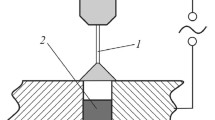Abstract
Peculiarities of variations in values of current and residual stresses and strains in welded joints on austenitic steels with a yield point of about 350 MPa and on high-strength alloys with σ0.2 ~ 800 MPa were studied. Evaluation of the stress-strain state in the HAZ and weld metal allows the causes of formation of hot and probably cold cracks to be explained, and methods for controlling them on the basis of absolute values of residual stresses and on the basis of variations in properties (including sensitivity to cracking) to be substantiated. The diagram of current quantitative values of σres. Иδres versus time for metal with the austenitic structure and different strength level was plotted in situ for the first time.
Similar content being viewed by others
References
Goldak J.A., Akhlaghi-Springer M.: Computational Welding Mechanics, 2005, 323 p.
Author information
Authors and Affiliations
Rights and permissions
About this article
Cite this article
Yushchenko, K.A., Makhnenko, V.I., Savchenko, V.S. et al. Investigation of Thermal-Deformation State of Welded Joints in Stable-Austenitic Steels and Nickel Alloys. Weld World 51, 51–55 (2007). https://doi.org/10.1007/BF03266600
Published:
Issue Date:
DOI: https://doi.org/10.1007/BF03266600




